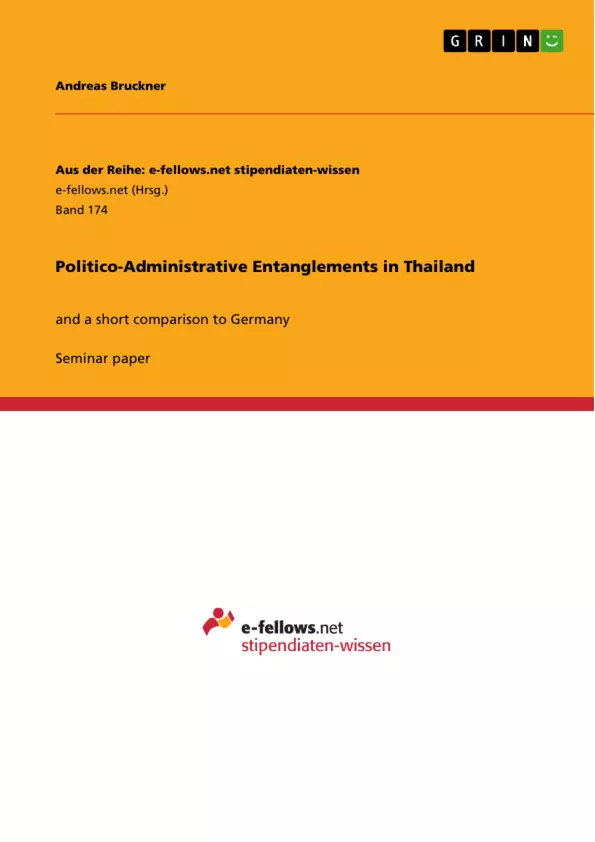This essay aims to outline above-mentioned politico-administrative entanglements in Thailand to
enhance the understanding of the current state of affairs. This means analysing one of Thailand’s mayor
shortcomings: the mutual influence of the state bureaucracy and state politics on public policies. At first, a
short briefing in historic public policy supremacies tries to deliver a background which will enable us to
better understand the roots of the entanglements and the self-perception of both parties involved. In the next step, the mutual influences will be disentangled, focusing on the gradual politicization of the bureaucracy first; the methods to bureaucratize politics will follow suit. Both cases will be divided into their formal and informal formats. In addition to the Thai conclusions, a comparison to the German case will be drawn. By sketching the historic and current German politico-administrative linkages and comparing them to the Thai case, this paper aims to analyse what preconditions and processes have led to different and similar pattern between Thai and German politico-administrative interconnections.
Inhaltsverzeichnis (Table of Contents)
- I. INTRODUCTION.
- II. A BRIEF HISTORY ON SHIFTING PUBLIC POLICY SUPREMACIES.
- III. THE POLITICIZATION OF THAI BUREAUCRACY.
- FORMAL PROCEDURES.
- INFORMAL PROCEEDINGS
- IV. THE BUREAUCRATIZATION OF THAI POLITICS.
- FORMAL PROCEDURES.
- INFORMAL PROCEEDINGS
- V. CONCLUSIONS
- A SOUTHEAST ASIAN PATH DEPENDENCE
- A THAI PERSPECTIVE.
- A GERMAN PERSPECTIVE
Zielsetzung und Themenschwerpunkte (Objectives and Key Themes)
This essay aims to provide a comprehensive understanding of politico-administrative entanglements in Thailand, focusing on the mutual influence of the state bureaucracy and state politics on public policies. The paper aims to achieve this by analyzing the roots of these entanglements and the self-perception of both the bureaucracy and politicians.
- Shifting public policy supremacies in Thailand's history.
- Politicization of the Thai bureaucracy and its formal and informal methods.
- Bureaucratization of Thai politics and its formal and informal proceedings.
- Comparison of politico-administrative linkages in Thailand and Germany.
Zusammenfassung der Kapitel (Chapter Summaries)
- I. INTRODUCTION: This chapter introduces the concept of politico-administrative entanglements and its relevance to the current situation in Thailand. It highlights the power struggles between bureaucrats and politicians, emphasizing their competing interests and the evolution of their relationships over time. The chapter also introduces the notion of a "zero-sum" political game in Thailand, where both sides try to gain the upper hand.
- II. A BRIEF HISTORY ON SHIFTING PUBLIC POLICY SUPREMACIES: This chapter provides a historical overview of the shifting power dynamics between the bureaucracy and political elites in Thailand. It traces the development of the Thai state from the establishment of the modern civil service to the rise of elected politicians and the liberalization of the “bureaucratic polity”. The chapter highlights key developments like the 1933 coup, the introduction of democratic reforms, and the subsequent oscillation between military and civilian leadership.
- III. THE POLITICIZATION OF THAI BUREAUCRACY: This chapter examines the increasing influence of politics on the Thai bureaucracy. It explores the tension between the need for political control and the desire for administrative flexibility and decentralization. The chapter focuses on the traditional focus on centralized political and administrative systems in Thailand and the constant tension surrounding political interference.
Schlüsselwörter (Keywords)
The paper centers around the themes of politico-administrative entanglements, bureaucratic polity, public policy supremacies, political influence, and power dynamics in Thailand. It examines the relationship between the Thai bureaucracy and politicians, exploring their historical evolution, current state, and comparison to the German case. This includes keywords like “patron-client relationships”, “bureaucratic elite”, “corruption”, “political patronage”, and “state intervention”.
- Quote paper
- rer. pol. Andreas Bruckner (Author), 2011, Politico-Administrative Entanglements in Thailand, Munich, GRIN Verlag, https://www.grin.com/document/176433



